Read the entire paper below!
Abstract
This study investigated the effect of double dipping on bacterial contamination. Ketchup and water was used to test 3 different situations. No saliva, Put in mouth and dipped. And spit into the substance. Each substance was swabbed onto separate Petri dishes and incubated under controlled conditions. Results showed minimal growth in control samples, increased growth in double-dipped samples, and heavy growth in saliva-contaminated samples. Notably, one saliva-contaminated sample displayed a large, fully black colony consistent with mold growth. Ketchup generally showed less bacterial growth than water, likely due to its acidity and thicker consistency, although both media exhibited clear differences between control and contaminated samples. These results support the hypothesis that double dipping measurably increases bacterial presence in shared food, and that the degree of contamination is influenced by the properties of the dipping medium.
1. Introduction
Background
Double dipping has been a controversial topic for countless decades. Generally, people agree that it is unacceptable in a formal setting due to the large amount of bacteria transmitted in the act. However, the magnitude of this bacterial transfer and the impact of it is still highly debated. Factors in the sauce, such as the viscosity, acidity, and sugar content may impact bacteria’s ability to be transmitted and grow. Limited data is available on the actual transmission of bacteria. This experiment sets out to determine if a sizeable amount of bacteria is actually transmitted from double dipping, and if this amount is influenced by properties of the dipping medium
Research Question
Does double dipping increase bacterial contamination in shared dipping media, and if so, what properties change that?
Hypothesis
We predict that double dipping in ketchup will result in very minimal bacterial transmission, and that double dipping in water and spitting in both will cause large amounts of bacterial transmission.
2. Materials and Methods
Materials
- Mask
- Ketchup
- Water
- Petri dishes
- Sterile cotton swabs
- Heating Pad (for Incubation)
- Gloves
- Measuring tools
- Camera (phone or regular) to photograph results
3. Experimental Procedure
- Preparation and Sterilization
- Wiped down the table and washed hands thoroughly.
- Put on latex gloves and a face mask to maintain a sterile environment.
- Sample Collection – Ketchup and Water
- Swabbed the ketchup and water samples using sterile Que tips.
- Transferred the swabs onto labeled agar plates.
- Placed the agar plates on heating pads to incubate.
- Sample Collection – Mouth and Sauce
- Held a sterile Que tip in the mouth for 5 seconds to collect oral bacteria.
- Dipped the same Que tip into the sauce sample.
- Used a new sterile cotton swab to transfer the combined sample onto a new agar plate.
- Labeled the plate and placed it on a heating pad.
- Control Sample
- Spit directly into ketchup/water (used as a control sample).
- Transferred the sample to a labeled agar plate and placed it on a heating pad.
- Observation
- Took pictures of the agar plates each day for the first three days to monitor bacterial growth.
- Analysis
- Observed and recorded results after the third day to analyze bacterial growth patterns.
Contamination Controls
To maintain a sterile environment, the table was wiped down prior to beginning the experiment. Gloves and a face mask were worn to minimize the risk of contamination from hand and mouth bacteria. Each substance was also tested beforehand to ensure it was free of existing bacterial contamination.
Incubation & Observation
- Incubated at 80 degrees for 3 days
- Took a photo for the first 3 days and then one more a couple of weeks later
4. Results
Control
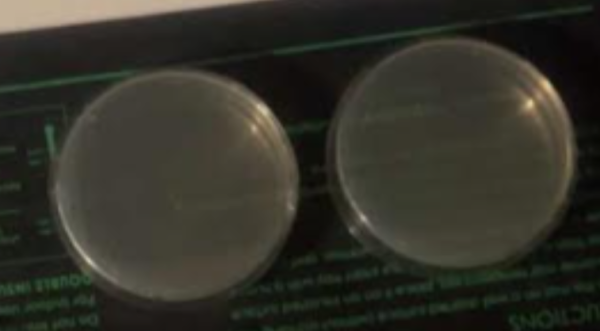
Ketchup and water have no initial bacteria before any contamination.
Day 1
Water (Double dipped on left, spit on right):
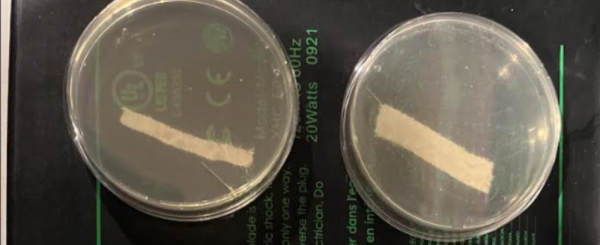
Small colonies begin to grow in both the double dipp(left) and the spit (right)
Ketchup (Double dipped on left, spit on right):
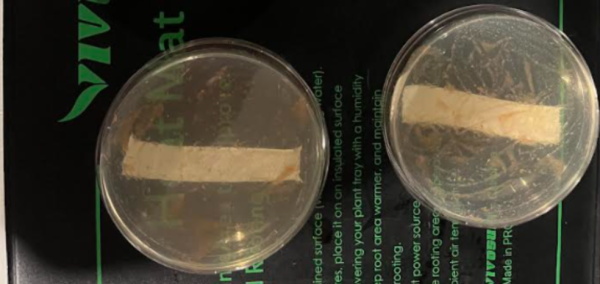
No noticeable colonies in either double dipp(left) and the spit (right)
Day 2
Water (Double dipped on left, spit on right):
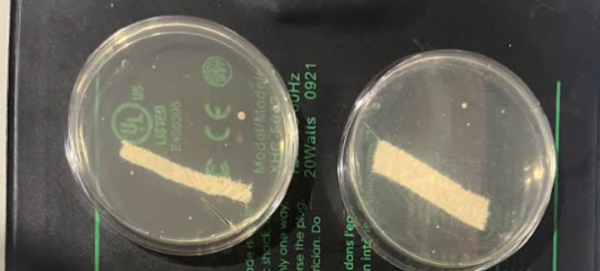
The colonies begin to grow larger in double dip (left) and the spit (right)
Ketchup (Double dipped on left, spit on right):
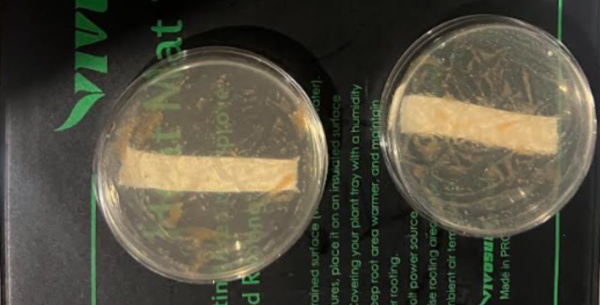
Very small colonies begin to grow in the spit one (right)
Day 3
Water (Double dipped on left, spit on right):
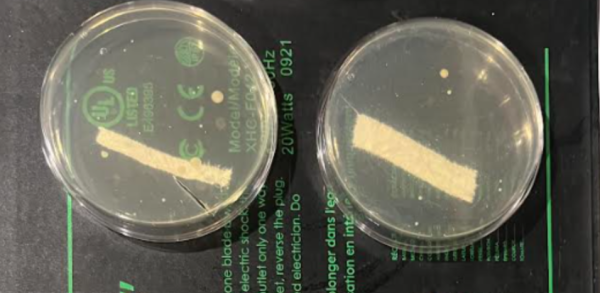
Colonies are a lot bigger and more are popping up in double dip (left) and the spit (right)
Ketchup (Double dipped on left, spit on right):
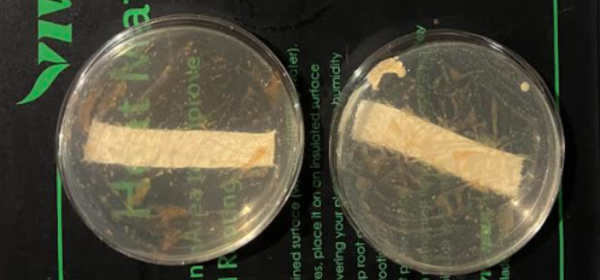
The colonies in the spit(right) grow very large
Day 14
Water (Double dipped on left, spit on right):
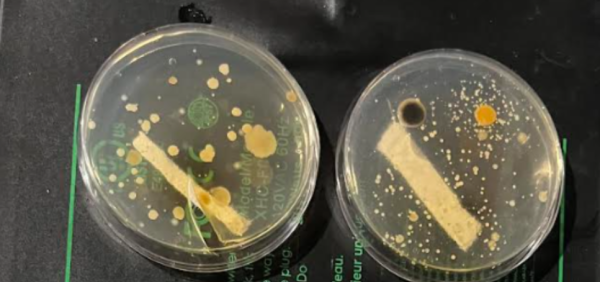
Both double dipp(left) and the spit (right) have a lot of colonies. The spit one has a lot of different colored colonies such as black.
Ketchup (Double dipped on left, spit on right):
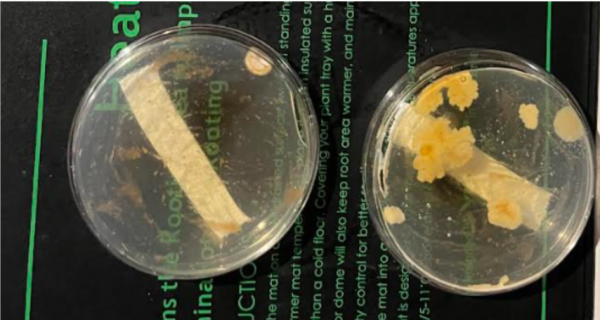
The Spit (right) has a lot of colonies while the double dipping has none
5. Discussion
Both water and ketchup had no initial bacteria in the control. This means any bacteria in further trials is due to either our purposeful contamination, or experimental error. In the double dipping trial, there is one singular bacterial colony visible in the ketchup petri dish. For the water, there is a high level of contamination with many colonies. In the controls for each, there is a high level of contamination which is expected.
These results support the initial hypothesis. The initial hypothesis stated that the ketchup would receive very low contamination due to double dipping, while the water would have high contamination. This is visible in the data collected.
The reason for this difference can be explained with the viscosity of the sauces. Because the ketchup is higher viscosity – so it is thicker – when the chip comes in contact with it the ketchup that touches the chip sticks to it. This minimizes the spread of bacteria as the contaminated ketchup sticks to the chip. With water, as soon as the chip touches the water, bacteria is spread instantly as the water moves. It is also possible that the ketchup’s acidity limited bacterial growth, but the control with spit showed a lot of bacterial growth for ketchup.
Some limitations for this experiment are the small sample size, the inaccurate measuring devices, and the possibility that the samples received contamination from a source other than the double dips. In a future experiment, a larger sample size can be used with a large variety of sauce and more detailed documentation. Also, more precise measuring tools and a lab with more sterile equipment.
6. Conclusion
The results of this experiment demonstrate that double dipping does transfer a small amount of bacteria into shared dipping media, producing more bacterial growth than untouched controls but less than direct saliva contamination. The type of dipping medium plays a role in bacterial survival and growth, with ketchup showing heavily reduced overall growth compared to water. This suggests that both physical properties (such as viscosity) and chemical properties (such as acidity) can influence bacterial proliferation. While the experiment was limited by sample size and qualitative growth assessment, the findings provide direct, visual evidence for the microbial risks of double dipping. Future experiments could improve on our findings by using more trials, a larger variety of sauces, more precise measures, and more error control.
7. References
De Jong MH;Van der Hoeven JS; “The Growth of Oral Bacteria on Saliva.” Journal of Dental Research, U.S. National Library of Medicine, 1987, pubmed.ncbi.nlm.nih.gov/3305628/.
Groove. “Agar and Petri Dishes Science Lesson.” Home Science Tools Resource Center, 29 July 2021, learning-center.homesciencetools.com/article/microscopic-agar-petri-dishes-science-lesson/
“Growing Bacteria in Petri Dishes.” Steve Spangler, 1 Oct. 2020, stevespangler.com/experiments/growing-bacteria/









